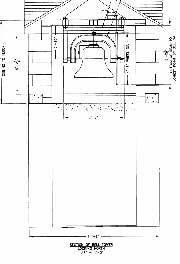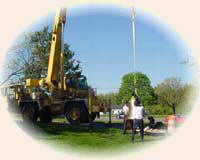|
"Hanging” the Tower… 
In
1995 St. George’s was made fully accessible by the
addition of an elevator housed in a new tower on
the west facade the church. The tower was built
with the intention of someday holding a bell at
its top—and structural provisions were made to do
so. Five years later the parish’s dream to “hang
the tower” (place a bell within it) came true when
two of St. George’s founding members, Bill and
Dottie Yeck, came forward and said “the time has
come.”
Months of research ensued involving Verdin Bells
of Cincinnati (one of the nation’s oldest and
largest installers of bells), John Ruetschle and
Associates (the architectural firm which designed
the tower), the Washington Township Zoning Board,
and others to insure that St. George’s bell would
be the largest, most beautiful, and most dynamic
bell appropriate for our tower.
Finally an ambitious plan was in place and a bell
was ordered that would swing and sound for
generations from our hill top.
St. George’s
Millennium Bell
Cast in solid bronze by the
Royal Dutch Bell
Foundry in Aarle-Rixtel, Holland, the bell has a
diameter of 42 1/2 inches and sounds the note of F
sharp. It can be heard up to two miles away. 
The bell incorporates a traditional English yoke
and wheel—the latter made of modern materials —
and swings back and forth with the help of a motor
controlled by a computer in the maintenance
office. St. George’s bell weighs 1.5 tons
and swings at a rate of 40 strokes a minute. The
bell is attached to the wheel by an antique yoke
that gives it traditional lines and grace.
The tradition of bell ringing is a long and
fascinating one - particularly in England. In
1552 Bishop Latimer said “If all the bells in
England were rung at one time there would scarcely
be a single spot where a bell would not be
heard.” To this day most large churches have a
bell ringing guild or society which practice and
ring the powerful bells several times each week.
In
days of old bells were a vital part of daily
life. They served as a communities principal
method of mass communication. Bells called the
faithful to church, proclaimed births and deaths,
summoned people to meetings, and gave warning and
directions in times of danger.
Each bell (which has its own personal name - i.e.
“Great Tom”) and its particular note was once
recognized by the community for its message.
Children were carefully taught to understand their
meaning. Ringing a combination of bells could
tell even more of the story (for example, a
certain sequence would relate “Death” “A Man.”
“Thirty seven years of age”) It is said that in
the Middle Ages a person knew the sound of their
village bell so well that no matter how far they
traveled they never forgot its note

|




